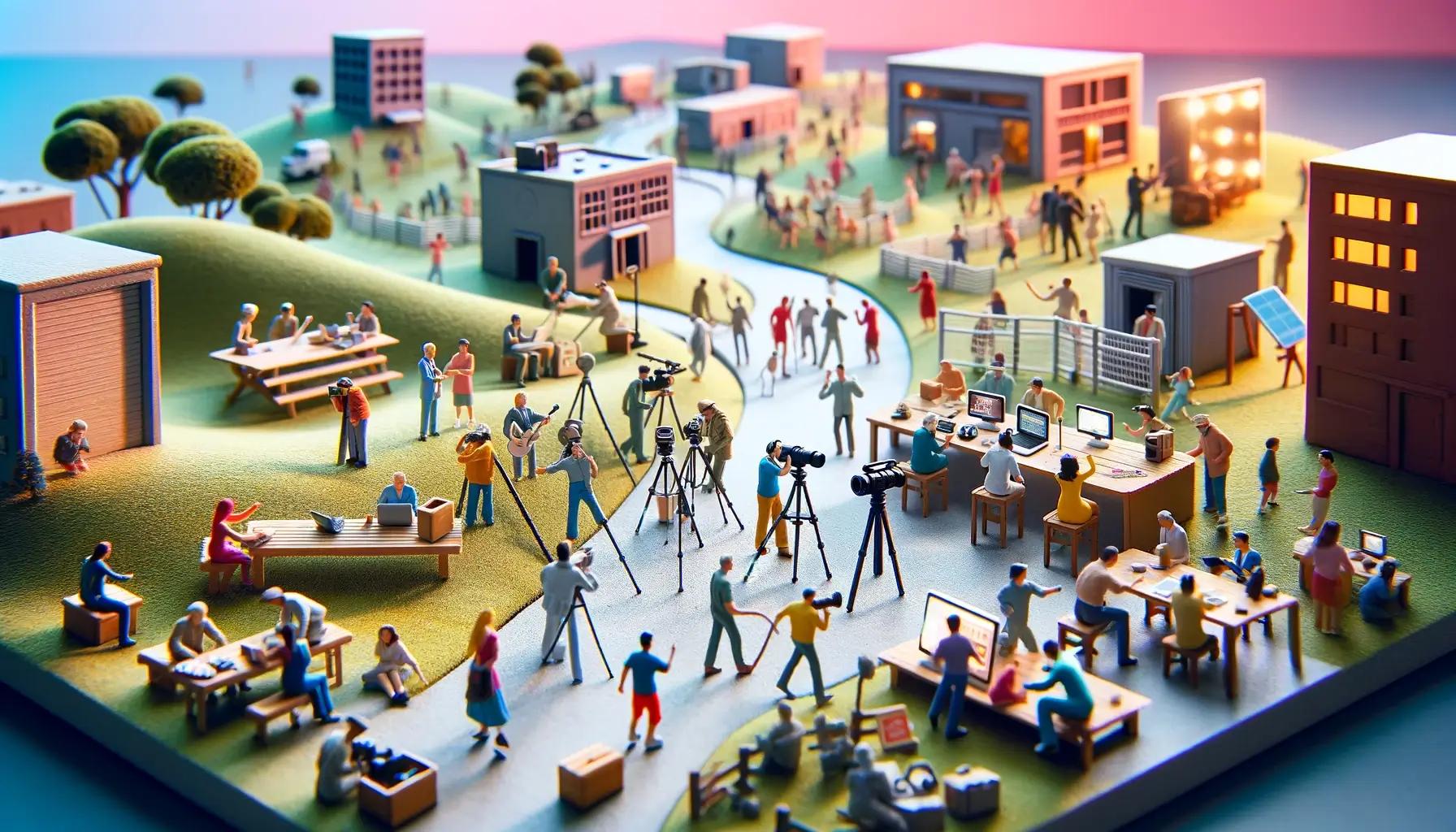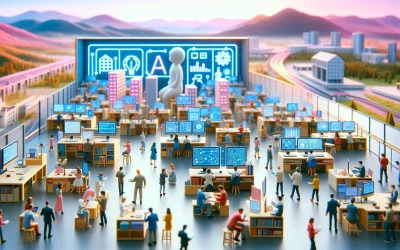The creator economy has been growing rapidly in recent years, with more people turning to platforms like YouTube, Twitch, and TikTok to showcase their talents and build a following. With the rise of artificial intelligence (AI), creators are finding new ways to enhance their content and reach a wider audience. From generating music to creating videos, AI is transforming the creator economy in ways that were once unimaginable.
One of the ways AI is impacting the creator economy is through the use of generative AI. This technology allows creators to generate content automatically, freeing up time and resources that can be used for other tasks. For example, musicians can use generative AI to create new melodies and beats, while video creators can use it to generate new visual effects and animations. This not only saves time but also allows creators to experiment with new ideas and styles.
Another way AI is impacting the creator economy is through the use of recommendation algorithms. These algorithms analyze user data to suggest content that is most likely to be of interest to them. This means that creators can reach a wider audience and build a following more quickly. Additionally, recommendation algorithms can help creators understand what their audience likes and dislikes, allowing them to tailor their content to better meet their needs.
Defining the Creator Economy
The Creator Economy refers to the ecosystem of individuals who make a living by creating and distributing content online. It encompasses a wide range of content types, including videos, music, podcasts, blogs, and social media posts. The Creator Economy has emerged as a significant force in recent years and is expected to continue its growth trajectory in the coming years.
Evolution of Content Creation
The Creator Economy has evolved significantly over the years. In the past, content creation was limited to traditional media outlets such as television, radio, and newspapers. However, the advent of the internet and social media has democratized content creation, enabling anyone with an internet connection to create and distribute content.
The rise of social media platforms such as YouTube, Instagram, and TikTok has played a significant role in the growth of the Creator Economy. These platforms have enabled creators to build large followings and monetize their content through advertising, sponsorships, and merchandise sales.
Role of AI in Content Monetization
AI is transforming the way creators monetize their content. AI-powered tools can help creators optimize their content for search engines, identify the best times to post, and analyze audience engagement. This data-driven approach can help creators increase their reach, engagement, and revenue.
AI is also enabling creators to monetize their content through new channels. For example, AI-powered voice assistants such as Amazon Alexa and Google Home are creating new opportunities for audio content creators. These devices enable users to access audio content hands-free, creating new opportunities for audio content creators to monetize their content.
AI-Driven Content Creation
The use of AI in content creation has revolutionized the way creators produce content. AI-powered content creation tools can automate and streamline various aspects of content production, such as generating written, audio, or visual content, editing and proofreading, and enhancing music and audio.
Automated Writing Tools
One way AI is impacting content creation is through automated writing tools. These tools use natural language processing (NLP) algorithms to generate written content based on specific inputs or patterns. Automated writing tools can help content creators save time and resources by generating high-quality content quickly and efficiently. However, they are not perfect and can produce errors or inaccuracies, which is why human editors are still necessary to ensure the quality of the content.
AI in Video and Image Generation
AI is also being used to generate video and image content. AI-powered algorithms can analyze data and generate images or videos based on the input data. For example, AI can generate realistic-looking images of people, places, or objects, or even create entire videos from scratch. This technology can help content creators produce high-quality videos and images quickly and efficiently.
Music and Audio Enhancement AI
AI is also being used to enhance music and audio content. AI-powered tools can analyze audio data and automatically adjust elements such as volume, pitch, and tempo to improve the overall quality of the audio. Additionally, AI can be used to create new music based on specific inputs or patterns. These tools can help content creators produce high-quality music and audio content more efficiently.
AI Tools for Audience Growth
AI is revolutionizing the creator economy by providing creators with tools to grow their audience and improve engagement. Two such tools are predictive analytics and personalization and recommendation algorithms.
Predictive Analytics for Creators
Predictive analytics is a type of AI that uses data mining, machine learning, and other techniques to analyze historical data and predict future outcomes. In the creator economy, predictive analytics can help creators identify trends and patterns in their audience’s behavior, preferences, and engagement levels. This information can be used to create more targeted content that resonates with the audience, resulting in increased engagement and growth.
For example, a creator can use predictive analytics to determine the best time to post content, the type of content that performs well with their audience, and the optimal length of their content. By using this information, creators can improve their content strategy and increase their reach and engagement.
Personalization and Recommendation Algorithms
Personalization and recommendation algorithms are another type of AI tool that can help creators grow their audience. These algorithms use data such as browsing history, search history, and social media activity to recommend content to users that they are likely to enjoy.
In the creator economy, personalization and recommendation algorithms can be used to suggest content to users based on their interests and preferences. This can help creators increase their reach and engagement by exposing their content to new audiences.
For example, a creator can use personalization and recommendation algorithms to recommend their content to users who have engaged with similar content in the past. This can help the creator reach a wider audience and increase their engagement levels.
Monetization Through AI
The Creator Economy is a vast and growing industry that is becoming increasingly reliant on AI-powered monetization tools. AI is helping creators to monetize their content more effectively and efficiently. Here are two ways AI is doing that.
AI-Powered Advertising Platforms
AI-powered advertising platforms like Google AdSense and Facebook Ads are becoming increasingly popular among creators. These platforms use machine learning algorithms to analyze user data and deliver targeted ads to the right audience. This means that creators can earn more money from their content by displaying ads that are relevant to their audience.
Moreover, AI-powered advertising platforms are also helping creators to optimize their ad revenue. These platforms use machine learning algorithms to analyze user behavior and determine the best ad placement, ad format, and ad frequency. This means that creators can maximize their ad revenue without compromising the user experience.
Sponsorship Matching with AI
AI is also helping creators to find sponsorship opportunities that are relevant to their audience and brand. Sponsorship matching platforms like Grapevine Logic and FameBit use machine learning algorithms to analyze creator data and match them with relevant sponsors.
These platforms take into account factors like the creator’s audience demographics, engagement metrics, and content niche to find the best sponsorship opportunities. This means that creators can earn more money from sponsorships that are relevant to their audience and brand.
Challenges and Ethical Considerations
As with any new technology, the use of AI in the creator economy has brought about its own set of challenges and ethical considerations. In this section, we will explore some of these concerns.
Content Authenticity Concerns
One of the main concerns with AI-generated content is the authenticity of the content. While AI can create content quickly and efficiently, it may lack the creativity and nuance that comes with human creation. This can lead to a lack of originality and quality in the content produced.
To address this concern, creators need to maintain an active role in overseeing AI-generated content. By doing so, they can ensure that the content aligns with their values and meets the needs of their audience. Additionally, creators can use AI to assist in the content creation process, rather than relying solely on AI-generated content.
AI Bias and Fairness
Another concern with the use of AI in the creator economy is the potential for bias in AI algorithms. AI algorithms are only as unbiased as the data they are trained on. If the data is biased, then the AI will be biased as well.
To address this concern, creators need to ensure that the data used to train AI algorithms is diverse and representative. Additionally, creators can use tools to test for bias in their AI algorithms and make adjustments as needed. By doing so, creators can ensure that their AI-generated content is fair and unbiased.
Future Trends in AI and the Creator Economy
Emerging AI Technologies
As AI continues to evolve, creators will have access to more advanced and sophisticated tools that can help them produce higher quality content more efficiently. One emerging technology that is already making waves in the creator economy is generative AI. Generative AI allows creators to generate content automatically, saving them time and effort. For example, ChatGPT and Adobe Firefly are two popular generative AI tools that can help creators generate text and graphics respectively.
Another emerging technology is computer vision, which can help creators improve the quality of their images and videos. Computer vision can help identify objects, people, and other elements in an image or video, allowing creators to make more informed decisions about how to edit and enhance their content.
Potential Market Shifts
AI is also expected to have a significant impact on the market for creator services and products. For example, AI-powered tools could make it easier for creators to monetize their content by providing them with more accurate data about their audience and their preferences. This could lead to new revenue streams for creators, such as personalized merchandise and sponsorships.
At the same time, AI could also lead to increased competition in the creator economy. As AI tools become more accessible and affordable, more people may be able to enter the creator economy and compete for attention and revenue. This could make it more difficult for creators to stand out and succeed in the market.




